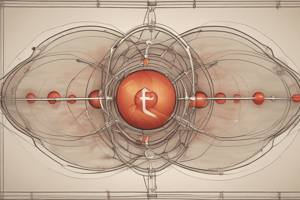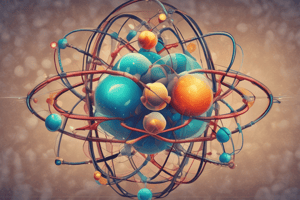Podcast
Questions and Answers
What determines the element of an atom?
What determines the element of an atom?
- Total number of electrons in the atom
- Number of protons in the nucleus (correct)
- Number of electrons in the outermost shell
- Number of neutrons in the nucleus
What is the principle that states electrons occupy the lowest available energy level?
What is the principle that states electrons occupy the lowest available energy level?
- Hund's rule
- Aufbau principle (correct)
- Pauli's exclusion principle
- Heisenberg's uncertainty principle
What is responsible for the attraction between protons and neutrons in the nucleus?
What is responsible for the attraction between protons and neutrons in the nucleus?
- Electromagnetic force
- Ionization energy
- Weak nuclear force
- Strong nuclear force (correct)
What is the pattern of light emitted or absorbed by atoms?
What is the pattern of light emitted or absorbed by atoms?
What is the energy required to remove an electron from an atom?
What is the energy required to remove an electron from an atom?
What is the mathematical equation that describes the behavior of electrons in an atom?
What is the mathematical equation that describes the behavior of electrons in an atom?
Flashcards are hidden until you start studying
Study Notes
Atomic Structure
- An atom consists of three main parts:
- Protons: positively charged particles in the nucleus (center)
- Neutrons: particles with no charge in the nucleus
- Electrons: negatively charged particles orbiting the nucleus
- Atomic number (Z): number of protons in an atom's nucleus, which determines the element
- Mass number (A): total number of protons and neutrons in an atom's nucleus
Electron Configurations
- Electron shells: energy levels around the nucleus where electrons occupy
- Shells are divided into subshells (s, p, d, f) with specific capacities
- Aufbau principle: electrons occupy the lowest available energy level
- Pauli's exclusion principle: no two electrons in an atom can have the same set of quantum numbers
- Hund's rule: electrons occupy degenerate orbitals with parallel spin before pairing up
Atomic Interactions
- Electromagnetic force: attraction between oppositely charged particles (protons and electrons)
- Strong nuclear force: attraction between protons and neutrons in the nucleus
- Weak nuclear force: responsible for certain types of radioactive decay
- Ionization energy: energy required to remove an electron from an atom
- Electron affinity: energy released when an electron is added to an atom
Quantum Mechanics
- Wave-particle duality: electrons exhibit both wave-like and particle-like behavior
- Heisenberg's uncertainty principle: impossible to know both position and momentum simultaneously
- Schrödinger equation: mathematical equation describing the behavior of electrons in an atom
- Orbitals: probability distributions of electrons in an atom
Spectroscopy
- Atomic spectra: patterns of light emitted or absorbed by atoms
- Emission spectra: light emitted when electrons transition to a lower energy state
- Absorption spectra: light absorbed when electrons transition to a higher energy state
- Spectral lines: specific wavelengths of light corresponding to energy transitions
Atomic Structure
- An atom consists of three main parts: protons, neutrons, and electrons
- Protons are positively charged particles in the nucleus (center) of an atom
- Neutrons have no charge and are found in the nucleus
- Electrons are negatively charged particles that orbit the nucleus
Atomic Number and Mass Number
- Atomic number (Z) is the number of protons in an atom's nucleus, determining the element
- Mass number (A) is the total number of protons and neutrons in an atom's nucleus
Electron Configurations
- Electron shells are energy levels around the nucleus where electrons occupy
- Shells are divided into subshells (s, p, d, f) with specific capacities
- Aufbau principle: electrons occupy the lowest available energy level
- Pauli's exclusion principle: no two electrons in an atom can have the same set of quantum numbers
- Hund's rule: electrons occupy degenerate orbitals with parallel spin before pairing up
Atomic Interactions
- Electromagnetic force: attraction between oppositely charged particles (protons and electrons)
- Strong nuclear force: attraction between protons and neutrons in the nucleus
- Weak nuclear force: responsible for certain types of radioactive decay
- Ionization energy: energy required to remove an electron from an atom
- Electron affinity: energy released when an electron is added to an atom
Quantum Mechanics
- Wave-particle duality: electrons exhibit both wave-like and particle-like behavior
- Heisenberg's uncertainty principle: impossible to know both position and momentum simultaneously
- Schrödinger equation: mathematical equation describing the behavior of electrons in an atom
- Orbitals: probability distributions of electrons in an atom
Spectroscopy
- Atomic spectra: patterns of light emitted or absorbed by atoms
- Emission spectra: light emitted when electrons transition to a lower energy state
- Absorption spectra: light absorbed when electrons transition to a higher energy state
- Spectral lines: specific wavelengths of light corresponding to energy transitions
Studying That Suits You
Use AI to generate personalized quizzes and flashcards to suit your learning preferences.




